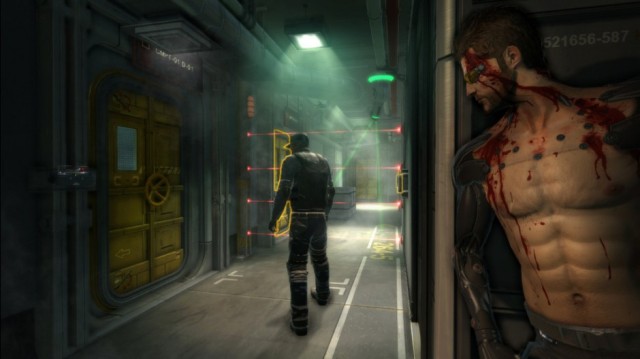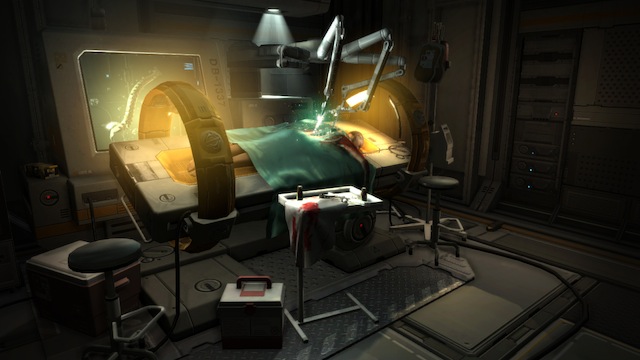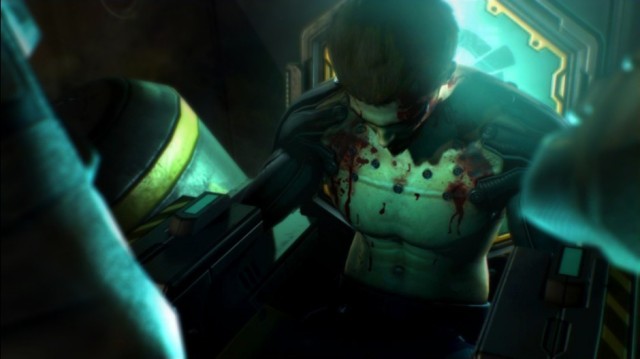Deus Ex: Human Revolution: The Missing Link Review
 Game: Deus Ex: Human Revolution: The Missing Link
Game: Deus Ex: Human Revolution: The Missing Link
Developer: Eidos Montreal
Publisher: Square Enix
Available on: Xbox 360, PlayStation3, Windows PC (Reviewed on Xbox 360)
When Deus Ex: Human Revolution was released back in August, it received universally consistent reviews which praised its gameplay, art direction and level design whilst criticising its boss fights and questioning its ending. Despite the reservations of most reviewers, the game was declared an overall success and a worthy successor to the original Deus Ex. Two months later, the first DLC, The Missing Link, has arrived. Does it improve on Human Revolution’s (almost) winning formula, or is it a trip that only the most die-hard fans will want to take?
Just over halfway through Human Revolution, our gravelly-voiced biomechanical hero Adam Jensen stows away aboard a cargo vessel in a stasis pod, only to awake days later to find that he’s been “off the grid” the entire time, unreachable even by communications expert Frank Pritchard. The Missing Link follows Jensen during those lost days, and expands upon aspects of the plot left unexplained at the end of the main game, such as the activities of shady mercenary firm Belltower, the genesis of the terrifying Hyron Project and the full extent of Megan Reed’s research.
If none of those things mean anything to you, it’s probably best to stop reading now, because The Missing Link is really best enjoyed after a full playthrough of Human Revolution, though it might be interesting to play the two in chronological order, breaking from the main game to play The Missing Link at the point where Jensen enters the stasis pod. In fact, the ease with which The Missing Link fits into Human Revolution’s narrative raises a question that’s been around as long as DLC: why wasn’t it included in the main game? Whilst some DLCs are experimental in nature, offering something different from their parent title in a low-stakes environment, The Missing Link can be described, both in terms of story and gameplay as “more of the same”.
Not that that’s such a bad thing, especially when the original game is of such high quality. The Missing Link’s storyline is consistently intriguing and fast-paced, seeing Jensen wake up aboard a heavily guarded vessel, escape onto a remote rig in the middle of the sea and proceed to penetrate the facility, uncovering its secrets as he goes. Unsurprisingly for a series which explores corporate corruption, the plot focuses on the secret activities of Belltower Associates, the military contractors who make Jensen’s life so difficult in Human Revolution. Predictably enough, these activities involve unethical experiments and human trafficking, which explains the ease with which Jensen was able to stow away on their ship in the first place.
The game begins with Jensen in an EMP chair which has disabled all of his biomechanical augmentations, leaving him defenceless as Belltower thugs torture him, trying to ascertain who he is working for, and what he is doing aboard their vessel. When they decide to take a break, an unknown benefactor releases the chair’s fastenings, allowing Jensen to escape. From there, it’s simply a matter of getting his equipment back, escaping from the ship unnoticed (or at least alive) and infiltrating the secret Belltower base. Business as usual, then.

At first, the graphics look exactly the same as those in Human Revolution. There are apparently some improved lighting effects in evidence, but the difference isn’t especially noticeable until you venture onto the deck of the vessel where you’re being held. It turns out the ship is in the middle of a stormy ocean (at night, of course), and as the rain lashes the deck, the ship sways, buffeted by monstrous grey waves. It’s certainly impressive, and makes a nice change from the deliberate claustrophobia induced by Human Revolution’s artfully cluttered environments.
The other conspicuous addition to the graphical proceedings is Jensen’s chest, rendered bare after Belltower removed his body armour to torture him more efficiently. Although his abs have a slightly “sprayed on” quality (maybe they’re augmented, I don’t know), it makes for an attention-grabbing introduction to the game, particularly if you’ve managed to avoid the ubiquitous publicity shots of Jensen moodily drinking whiskey with his shirt off. His flesh is wrought with metal struts and plugs that hold his mechanical arms in place, a sight that will be wince-inducing to the squeamish.
Although The Missing Link’s overall sound design is extremely similar to Human Revolution’s, the vocal performances are distinct enough to warrant a mention. Most appealing is engineer Garvin Quinn’s Irish accent, which makes you feel genuinely sad that you can’t join him for the “pint” he mentions part-way through the game. An already interesting character with an augmentation that encircles his face with a strange disc, Quinn adds much-needed warmth to the otherwise lonely proceedings.

The oddly-pitched synthetic loudspeaker which echoes throughout the Belltower base is oddly reminiscent of Portal’s GLaDOS, and the pained cries of test subjects that you hear as you penetrate deeper give the game an ominous atmosphere, but other than that, Missing Link’s sound design is functional rather than astonishing.
Although there’s no difference between Human Revolution’s gamplay and The Missing Link’s, Eidos Montreal have made the interesting decision to remove all Jensen’s augmentations, and allow the player to start from scratch. Because you can’t load saves from one game into another, your decisions won’t affect future replays of Human Revolution, meaning that you’re encouraged to experiment with augmentations you wouldn’t usually use. Although this breaks the game’s immersion a little (why does Jensen wake up in Singapore with exactly the same augmentations he had in Hengsha if he had to start again in between?), the freedom to experiment when you know you only have a few hours to live with your decisions is welcome.
That said, you’re clearly funnelled down the stealth route from the beginning, and players who favour the more full-on approach will find the game difficult if they don’t choose their augmentations carefully. The unknown benefactor who communicates with you through a neural augmentation in your brain repeatedly tells you that he would prefer it if you stay quiet, and many areas will overwhelm you if you run in all guns blazing, especially near the beginning when you don’t have any Praxis kits. Overall, the gameplay is tight, engaging and satisfying, rewarding exploration with nice pickups or some new information that enriches the world.
The level design is as good as you’d expect, which is fortunate because the quests have you going back and forth between areas a number of times. One fetch quest in particular has you scouring hidden areas in search of a few specific items, and it’s only the coherence of the world that stops this being a chore. Like all good games, The Missing Link’s environments reveal as much about the story as the characters and dialogue, and there’s a nice contrast between the gleaming interior of the ship, the industrial might of the docking bay and the disturbing dark of the base’s interior. It’s good to see that the attention to detail that made Human Revolution such a joy to explore are still present here.

Further to this, The Missing Link deserves praise for its omission of the tiresome boss fights that made Human Revolution somewhat less than perfect. Although there is a definite “boss”, it’s one that can be approached in any way. Despite that fact that it won’t win any prizes for ingenuity, it’s consistent with the game in a way Human Revolution’s definitely weren’t. In fact, gameplay on the whole nicely balanced, except for the conversations, which are few and far between. In fact, there are only a couple of occasions where you can use your social augmentation, a shame considering that with its focus on personality types and intelligent reasoning, it’s one of the most interesting features in the entire game.
The only other thing that blights the gameplay (at least on the Xbox 360 version) is a number of small bugs, a shame considering the game’s otherwise high production values. These involve clipping, being frozen to the spot, and in one instance, ending up on the other side of a wall after crouching. It’s a real shame that these made it into the released version, because although they aren’t game-breaking, they destroy the immersion and the sense of place that are so important to the Deus Ex experience.
This being a Deus Ex game, there will always be the compulsion to re-play the game a second time to try out a different path. If you’ve heeded your unknown benefactor’s advice and kept hidden throughout the mission, you’ll want to know what happens if you don’t. The ending presents you with the kind of dilemma that’s typical of the series, and although there’s a hidden way to get the best of both worlds, many players will want to explore both scenarios. But besides its inherent replayability, The Missing Link is disappointingly short for its price. Even when you complete all the side quests, the game barely stretches to five hours, which is very little when you compare it to some of the other games available for the same price on the XBLA, PSN or Steam.
VERDICT: Were The Missing Link a level in Human Revolution, it would have ranked as a high point, but as a standalone title for a high cost, it’s slightly lacking. There’s nothing – pardon the pun – revolutionary about it, and it’s a shame that Eidos Montreal weren’t more experimental, perhaps giving fans another character to play with and thus another perspective on Deus Ex’s magnificent world. The bugs, whilst minor, break the game’s precious immersion, and are difficult to forgive in a title so expensive.
But with that in mind, everything that players loved about Human Revolution is present here. There’s a solid plot told through dialogue, “e-mails” and environments, the gameplay is solid and there aren’t any dreadful boss fights. If you loved Human Revolution and don’t mind a low time-to-cost ratio, there are many worse ways to spend an afternoon.






